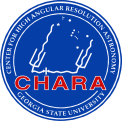At Least Two Weeks Before Your Observing Run
- For onsite observing, follow instructions in Lodging at the CHARA Array to reserve a room on the mountain.
- For remote observing, please follow the instructions on the remote observing page. If you wish to observe remotely, you must have prior on-site observing experience or have assistance from an experienced observer. If you have any questions about remote access, please contact our Data Scientist, Jeremy Jones (
This email address is being protected from spambots. You need JavaScript enabled to view it. ). Software and operations are evolving at CHARA, so if you have not observed in some time, please contact Chris Farrington (This email address is being protected from spambots. You need JavaScript enabled to view it. ) to find out about recent operational changes.
- For directions and additional travel information, see Traveling to CHARA at Mount Wilson.
Planning Observations
See the How to Plan an Observation page for instructions on planning observations at the CHARA Array.
For NOIRLab observers: Please contact our Visitor Support Scientists, Cyprien Lanthermann (
For internal consortium members: Please contact Chris Farrington (
Sending Your Setup Request to the CHARA Team
Observers should send their configuration request at least two days prior to the beginning of the scheduled time. Please use the new form to send your configuration setup requests. If your run spans multiple nights, please send an updated request after each night or specify that the same configuration will be used on all nights. The request is sent to both the day-time and night-time staff. It is used to align the lab during the day and to set the configuration and slew to the first target at the start of the night. If you prefer to send your request via email instead, please send to
- Date of program
- PI and program ID
- Beam combiner(s)
- Telescopes in first configuration and any changes during the night
- Beam order (if you have a preference - see explanation)
- PoP combination to start.
- Filter for CLASSIC or CLIMB: K', H, J
- Spectral Mode for MIRCX/MYSTIC: Prism50, Prism102, Grism190, etc.
- First target or check star. Please specify if the first target is an alignment star, fringe finder, calibrator, or object.
- Any special requirements you might have (LDCs, CLIMB for fringe finding/tracking, non-standard AO beam splitter).
- For MIRC-X/MYSTIC, if your first target does not have 6T delay, please specify which telescopes you want to be in delay at the start and whether you want light on all 6 telescopes.
- Communication with the array operators is currently done through the night-time-operations channel of the CHARA discord server. Please contact Chris Farrington or Jeremy Jones if you need an invitation to Discord. Skype can be used as a backup.
If you have faint targets, please provide finding charts for the telescope operator. The finder camera has a field of view of 27 x 43 arcmin. The acquisition camera has a field of view of 3.5 x 5.2 arcmin.
If you have made arrangements to have the array operator assist you with collecting the observations (e.g., if you are unable to be on the mountain and don't have access to a Remote Observing Center), then please include a detailed schedule for the night. This can be sent as a text file, aspro file, pdf file, or excel spreadsheet and should include the following information:
- UT range and baseline/POP configuration for each target
- List of science target and calibrators (HD number, RA, DEC, Vmag, Kmag, diameter)
- Calibration strategies, instrument settings, etc.
On the Night of Observation
Please arrive in the control room or the remote observing center before sunset. The Array Operator can provide an update on the status of the array and current conditions. In the case of inclement weather, the Array Operator will inform the observers whether to go on stand-by or to cancel the night. The work schedule for the Array Operators is posted in the Observing Schedule. The operator will begin opening the telescopes around 6 degree twilight, and science observations usually begin around 12 degree twilight.
Links for Detailed Observing Procedures
- Instrument Pages: Manuals, Observing Logs, and References
- CHARA Wiki Page
- Links for Instrument Manuals on CHARA Wiki
- Recent fringe offsets
- CHARA Telescope Spy Cams
- Mount Wilson HPWREN Cameras
- Weather Forecasts for Mount Wilson
- Current Conditions at Mount Wilson Observatory
- Mount Wilson Observatory Weather Station



